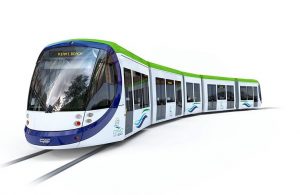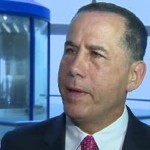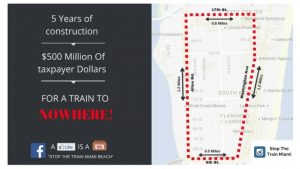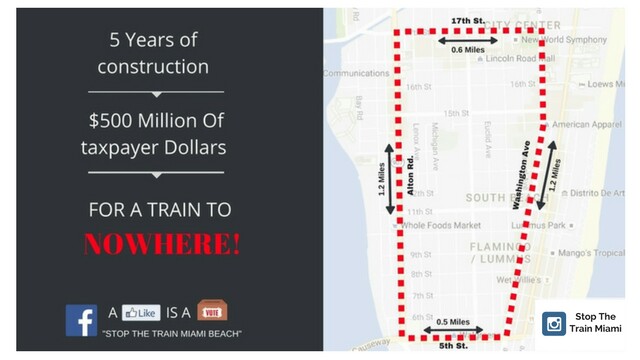Proponents and opponents of an imagined light rail train that loops around South Beach will  discuss the pros and cons of the project at a community forum Thursday night organized by Miami Beach United.
discuss the pros and cons of the project at a community forum Thursday night organized by Miami Beach United.
Last we heard, there are three possible deals on the table, all from qualified bidders. Proposals are due Nov. 3. But everybody seems to believe that Alstom is the favored vendor after Mayor Philip Levine and City Manager Jimmy Morales traveled to France to meet with them. Morales was instructed by the commission to begin negotiations with Alstom in July.
The rail, which the community is calling a streetcar, will loop around South Beach from the convention center to 5th Street and from Dade Boulevard and Alton Road to Washington Avenue. It is expected to cost about $387 to build and $16 million a year to operate (at first because that grows). And it is projected to take five years to build.
This comes after Levine, Miami Mayor Tomas Regalado and Miami-Dade  Mayor Carlos Gimenez apparently lost their marbles and agreed last year to seek their rail systems separately. They abandoned plans for Bay Link that would cross the MacArthur Causeway and connect the Beach with downtown Miami until later. And they basically rejected more than $8 million already secured in state funding for a new study. All each city had to provide was $417,000. And they might still be able to get federal funding.
Mayor Carlos Gimenez apparently lost their marbles and agreed last year to seek their rail systems separately. They abandoned plans for Bay Link that would cross the MacArthur Causeway and connect the Beach with downtown Miami until later. And they basically rejected more than $8 million already secured in state funding for a new study. All each city had to provide was $417,000. And they might still be able to get federal funding.
Supporters say the loop is a good first step to the eventual Bay Link and that it will take cars off the street.
Opponents it will make traffic worse because it will cause chaos on Beach streets as they are torn up  once again and because it’s made for tourists. Most locals would rather walk five blocks than go around what they call “Levine’s loop” or “the train to nowhere” and many say it is a waste of taxpayer funds. It could also be called the Alex Heckler express since the lobbyist (who just hosted a fundraiser with Levine for Miami-Dade Mayor Carlos Gimenez) is the one promoting this idea.
once again and because it’s made for tourists. Most locals would rather walk five blocks than go around what they call “Levine’s loop” or “the train to nowhere” and many say it is a waste of taxpayer funds. It could also be called the Alex Heckler express since the lobbyist (who just hosted a fundraiser with Levine for Miami-Dade Mayor Carlos Gimenez) is the one promoting this idea.
“Nobody wants this taxpayer paid train to cater to tourists,” said Commissioner Kristen Rosen-Gonzalez. “Levine has not listened to all the residents who do not want that train. And there are a lot of them.”
That’s why the forum tonight might turn into a train-trashing session. MBU’s stated goals are to:
- Educate residents on the Miami Beach Light Rail Project with some background on Miami-Dade County SMART plans
- Provide residents with “pros and cons” regarding the plan
- Identify ways residents can be engaged throughout the planning process
- Generate ideas and feedback for the Miami Beach Light Rail Plan
Nowhere does it say stop the train. But there will be people who want to do that. Robert Lansburgh, who leads the Stop the Train Miami Beach movement (more than 700 likes on Facebook) is  participating. So is Michael Barrineau, president of the South of Fifth Neighborhood Association. There are also light rail advocates like Mark Needle, an active resident of the Flamingo Park neighborhood.
participating. So is Michael Barrineau, president of the South of Fifth Neighborhood Association. There are also light rail advocates like Mark Needle, an active resident of the Flamingo Park neighborhood.
Activist Frank Del Vecchio will attend. He said the city has not answered 11 questions that the West Avenue Neighborhood Association has about the train’s impact to residents. He is concerned that the city has already entered into consulting contracts worth more than $6 million and hired staff dedicated to advance the project.
The questions are:
- What are the consultant reports and when are they due?
- Are the reports public record and how can they be accessed?
- Will the reports address the particulars of elevating tracks along the route addressing Sea Level Rise?
- Separated out, what is cost of streetcar? Of street raising? Of pump stations? Of intermodal transit facilities?
- Will the reports provide a construction budget and timetable?
- Will the street raisings be separately budgeted?
- What Streetcar and related items are in the recently approved 2016/2017 (both operating and capital)
- What is the current timetable for city commission consideration of and action on the Streetcar project: (Please identify the action item and the scheduled or expected date of consideration, and type of action required (Resolution, Ordinance, Budget amendment, Contract approval, etc.)
- Will the studies identify the required number of intermodal transit facilities, the minimum required capacity of each for number of trains to be serviced and stored, and the minimum number of vehicle parking spaces to be provided? Will the locations, either specific or approximate, of such facilities be provided?
- What agencies other than the City of Miami Beach are required to approve any aspect of the project, including configuration of State Roads located in Miami Beach that are included in the route? If State Roads are included in the route whose responsibility will be the raising of those roads for sea level rise purposes?
- What is the nature of the approval or approvals required? Please cite the relevant requirement(s).
Del Vecchio also has loads of other questions about connectivity and how committed the county and Metropolitan Planning Organization are to connecting light rail since they’ve been talking more and more about rapid bus transit. Furthermore, he points to some study that indicates traffic could actually increase because of left turn limitations caused by Levine’s loop.
Hopefully, these questions will be answered Thursday night at the forum, titled “Are We On The Right Track?” It will begin at 6 p.m. at the Miami Beach Woman’s Club, 2401 Pine Tree Dr. (Free parking at the Hebrew Academy).
But Ladra doubts the conversation will end there.

